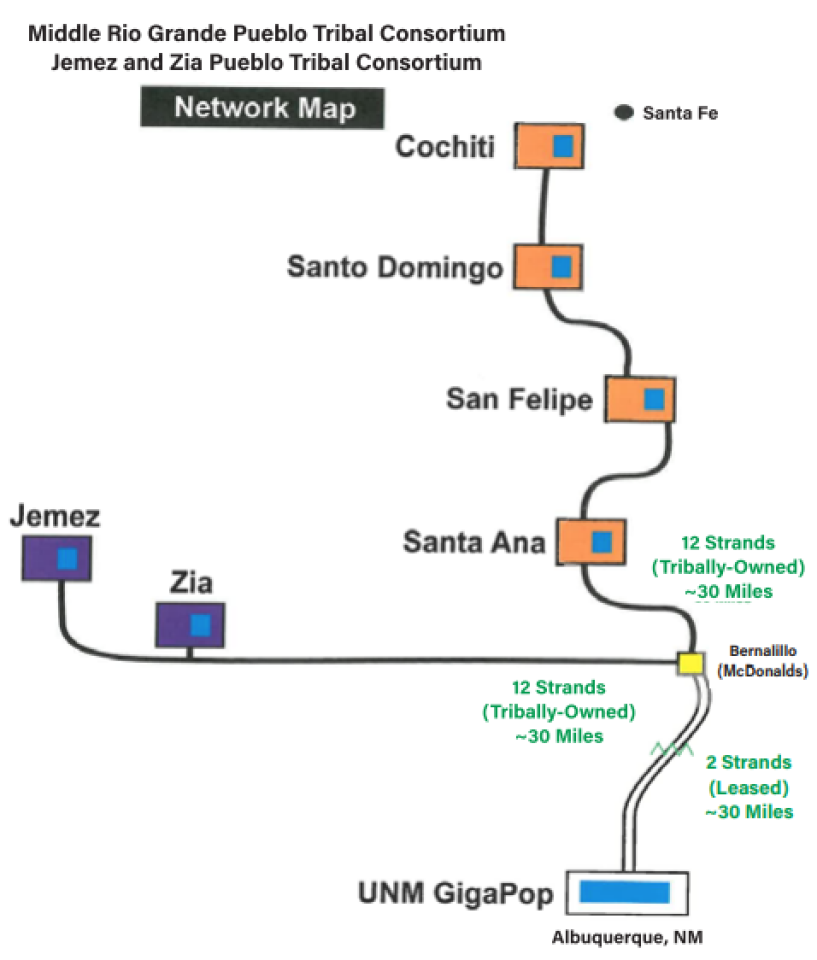
A new report out by the American Library Association shows how community anchor institutions — and libraries in particular — can serve as central players in expanding tribal connectivity efforts around the country. “Built by E-rate: A Case Study of Two Tribally-Owned Fiber Networks and the Role of Libraries in Making It Happen" [pdf] looks at the striking success of tribal efforts in New Mexico in putting together a coalition of actors to dramatically improve Internet access in the region.
The report examines networks built by two consortiums situated in the middle of the state in the summer of 2018: the Middle Rio Grande Pueblo Tribal Consortium and The Jemez and Zia Pueblo Tribal Consortium. An endeavor initially spearheaded by the Santa Fe Indian School (which long ago recognized the need for virtual learning, the value of fast, affordable Internet and the ongoing cost of slow, poor, high monthly costs), “Built by E-Rate” details how they came into being and the obstacles they faced along the way, and offers policy recommendations moving forward.

Faster Speeds, Lower Costs
Each project cost $4.2 million, with E-Rate funding covering 95% of the costs after each managed to secure state funding via general obligation bonds for their effort. They both consist of 30 miles of tribe-owned, 12-strand fiber and an additional 30 miles of two-strand dark fiber leased from Zayo, a privately owned fiber infrastructure outfit. Both terminate in the Albuquerque GigaPoP operated by the University of New Mexico — a nonprofit initiative to get affordable, high-speed broadband to educational and research institutions in the state. On average, the consortia increased Internet speeds from 3 EMgabits per second (Mbps)_ to 100Mbps while decreasing costs from $106/Mbps to $3/Mbps as a result of the new network. Both are well-positioned for scalability and future growth as well, with the ability to scale to 10Gbps.
The Middle Rio Grande Pueblo Tribal Consortium network runs south and connects four libraries in the Pueblos of Santa Ana, San Felipe, Santo Domingo, and Cochiti. The Jemez and Zia Pueblo Tribal Consortium comes in from the west, connecting two tribal libraries and two charter schools before linking up and heading south to Albuquerque.
The report offers some key takeaways from the undertakings: the critical role played by libraries in building trust, educating leaders, offering technical assistance, and providing ongoing digital literacy programs; the consortium approach, which provided a broader resource and talent base and helped overcome obstacles along the way; the 2014 modernization of the E-Rate program to include self-provisioned networks in funding applications; and pre-planning meetings with vendors and ISPs to account for local conditions while preserving timelines and keeping costs low.
It also details obstacles encountered along the way, with solutions found. The Middle Rio Grande Pueblo Tribal Consortium, for instance, ran into right-of-way (ROI) issues, which the tribes solved by codifying ROI changes in their charters so construction could proceed unimpeded. The Jemez and Zia Pueblo Tribal Consortium ran into construction delays which threatened the timeline stipulated by the E-Rate program because of federal regulations regarding historic and archeological considerations and surrounding geography which triggered audits to comply with the Clean Water Act. It rectified the delays by complying with regulations and then appealing to local elected officials to speed the compliance paperwork.
Recommendations
The report also offers a handful of policy recommendations:
- FCC must revise the definition of tribal libraries to be in keeping with the language in the 2018 reauthorization of the Museum and Library Services Act (MLSA) amending the definition of a library, so as to increase the number of tribal libraries that are eligible to participate in the E-rate program.
- The FCC should improve training opportunities for tribal libraries to increase awareness of and participation in the E-rate program.
- To maximize broadband opportunities at the federal and state levels, the Institute of Museum and Library Services (IMLS) is urged to convene workshops and increase support for tribal libraries to learn from and share experiences of the benefits of increased broadband connectivity.
- States are encouraged to support tribal libraries by explicitly including tribal libraries in state level initiatives and funding opportunities, as well as by lending technical and administrative assistance to tribal library E-rate application processes and procedures.
A Jemez-Zia Pueblo Tribal Consortium report [pdf] after the network went online shows just how dramatic the changes have been for some libraries in terms of connectivity costs and speeds. The Santa Felipe Pueblo Community Library, for instance, went from having two T1 lines capable of providing 3Mbps for $700/month (reduced to $23 by E-Rate) to having a fiber connection offering 100Mbps download speeds for $3/month (reduced to 30 cents by E-Rate). Even though the E-Rate program undoubtedly held old costs down, the new networks offer much faster speeds which will provide opportunities for online learning, economic development, and community services.
Read the full report below.








